

Simple Steps to Build a Complete SEO Strategy

Simple Steps to Build a Complete SEO Strategy
 14-03-2025 (Last modified: 30-06-2025)
14-03-2025 (Last modified: 30-06-2025)
SEO is one of those things everyone knows they should be doing, but very few actually get right – especially as things move fast in the SEO world and what may have been your strategy in 2021 definitely won’t cut it now! Website owners used to get away with stuffing their content with keywords or getting a few backlinks and that was enough to rank at a decent level. These days it’s more of a multi-layered approach that requires a mix of technical expertise, content strategy, and ongoing analysis. If you’ve ever wondered how to actually build a complete SEO strategy that works, then you’re in the right place!
Think of SEO like a recipe; miss one key ingredient, and the dish doesn’t quite taste right. That’s why we’re covering everything you need, from keyword research and on-page optimization to link building and technical SEO. These are the steps we use in our own SEO work and we’re sure they will be just as useful for you!

The Three Pillars of SEO: What You Need to Know
Let’s begin with the basics: A solid SEO strategy revolves around three core areas:
- On-Page SEO – The tweaks and optimizations you make on your website, like keywords, content, meta descriptions, and headings.
- Off-Page SEO – External factors like backlinks, social signals, and brand mentions that boost credibility.
- Technical SEO – The behind-the-scenes work, such as improving site speed, mobile usability, and crawlability.
Neglect one of these, and your rankings could suffer. Let’s go through them step by step.
Keyword Research: Finding the Right Search Terms
Before creating content, you need to know what people are actually searching for. Keyword research helps you uncover high-traffic, low-competition phrases that align with your audience’s intent.
How to Find the Best Keywords:
- Use Google’s autocomplete—start typing a keyword and note the suggestions.
- Check out the “People Also Ask” and “Related Searches” sections for more ideas.
- Utilize keyword tools like Google Keyword Planner, Ahrefs, SEMrush, and Ubersuggest.
- Focus on long-tail keywords (phrases with three or more words) since they have lower competition and higher conversion rates.
- Spy on competitors’ keywords—if they’re ranking well, analyze what they’re doing right and improve upon it.
For example, if you’re targeting fitness enthusiasts, “best running shoes” is too broad. Instead, “best running shoes for flat feet in 2025” is a long-tail keyword that is easier to rank for and more targeted.
On-Page SEO: Optimizing Your Content for Search & Users
Now that you’ve got your keywords, it’s time to use them the right way. Here’s what on-page SEO involves:
1. Craft Killer Title Tags & Meta Descriptions
Your title tag is the first thing users see in search results, so make it click-worthy. Points to remember:
- Keep it under 60 characters
- Place the main keyword near the beginning
- Make it engaging and action-driven
Your meta description should be enticing but also include your keyword naturally. Key points to remember:
- Stay under 160 characters ✔ Summarize what the page is about
- Use action words (e.g., “Discover,” “Learn,” “Get”)
For instance, instead of “SEO guide for beginners”, try “Want to rank higher? This beginner-friendly SEO guide will show you how.”

2. Optimize Your Content with the Right Structure
Google loves well-organized content. A proper structure makes it easier for both users and search engines to navigate your page. Points to keep in mind:
- Use H1 for the title, and H2s & H3s for subheadings
- Break up text with bullet points, bolding, and visuals
- Include internal links to relevant pages on your site to keep users engaged longer
For example, if you’re writing about mobile-friendly SEO, linking to an article on technical SEO best practices makes total sense.
3. Image Optimization for SEO
Images enhance user experience, but they can also slow down your site if not optimized properly. Points to remember:
- Use descriptive file names (e.g., “best-running-shoes-2024.jpg” instead of “IMG12345.jpg”)
- Add alt text so Google can understand the image
- Compress images to improve page speed
Off-Page SEO: Building Authority & Trust
Off-page SEO is all about credibility. Google looks at how other websites interact with yours to determine if your site deserves a higher ranking.
How to Build High-Quality Backlinks:
- Guest Blogging – Write articles for reputable websites in your industry.
- Broken Link Building – Find broken links on other sites and suggest replacing them with your content.
- Digital PR – Get featured on news sites, blogs, and industry publications.
- Create Link-Worthy Content – Infographics, case studies, and original research naturally attract backlinks.
- Leverage Social Media – While social signals don’t directly affect rankings, they can boost brand visibility and traffic.
A quick tip: Avoid spammy backlinks – buying links from shady sources can actually hurt your rankings. We recommend using a link trading platform such as 3Way Social where you can vet other domains, and purchase links and guest posts without risk.
Technical SEO: The Backbone of a Well-Optimized Site
Even the best content won’t rank if your site has technical issues. Here’s what you need to check:
- Mobile-Friendliness – With Google’s mobile-first indexing, your site must be optimized for mobile devices.
- Page Speed Optimization – Use tools like Google PageSpeed Insights to test load times.
- Secure Site (HTTPS) – A site without SSL encryption looks untrustworthy.
- Fix Crawl Errors – Regularly check Google Search Console for crawl issues.
- Use Schema Markup – Helps search engines understand your content better and can boost click-through rates.
Google favors fast, secure, mobile-friendly websites – so if your site takes 10 seconds to load, expect a high bounce rate.

Tracking Your SEO Progress
SEO is not a one-time task. You need to track what’s working and what’s not.
Best SEO Tracking Tools:
- Google Analytics – Monitor traffic, user behavior, and conversions.
- Google Search Console – See how your pages rank and fix any errors.
- Ahrefs / SEMrush – Track backlinks, competitor rankings, and keyword performance.
- PageTest.AI – Test different versions of your content to see what converts best.
Final Thoughts: A Winning Complete SEO Strategy
SEO isn’t a one-size-fits-all approach – it requires constant tweaking and testing. Here’s a quick recap of what to focus on:
- Keyword Research – Find the right search terms that match intent.
- On-Page SEO – Optimize content, structure, and internal linking.
- Off-Page SEO – Build credibility through backlinks and brand mentions.
- Technical SEO – Improve speed, security, and mobile usability.
- Content Strategy – Publish high-quality, valuable content that keeps users engaged.
- Analytics & Testing – Measure success and refine your strategy over time.
Want to dominate search rankings? Start implementing this complete SEO strategy today, and watch your traffic and conversions skyrocket!
say hello to easy Content Testing
try PageTest.AI tool for free
Start making the most of your websites traffic and optimize your content and CTAs.
Related Posts

 28-10-2025
28-10-2025
 Ian Naylor
Ian Naylor
Why Visual Stability Matters for Conversions
Learn how visual stability impacts user experience and conversions, and discover strategies to reduce layout shifts on your website.

 27-10-2025
27-10-2025
 Ian Naylor
Ian Naylor
Drag-and-Drop Testing: Boosting Conversions Without Code
Easily boost your website’s conversions with no-code drag-and-drop testing tools that simplify A/B testing and enhance team collaboration.

 25-10-2025
25-10-2025
 Ian Naylor
Ian Naylor
AI Translation Tools for Website Localization
Explore how AI translation tools enhance website localization by reducing costs, improving speed, and ensuring cultural relevance for global audiences.
